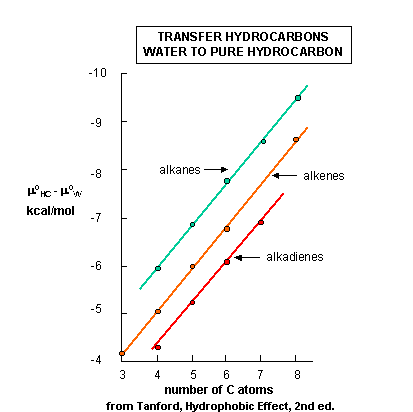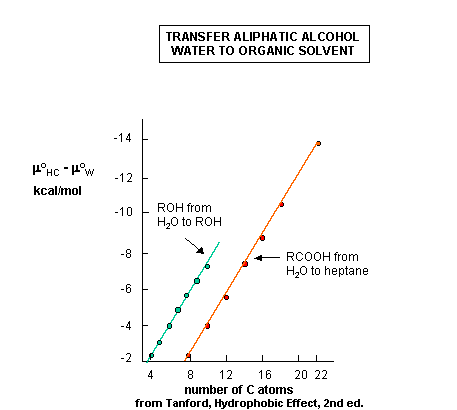Biochemistry Online: An Approach Based on Chemical Logic

CHAPTER 1 - LIPID STRUCTURE
D: Lipids in Water - Thermodynamics
BIOCHEMISTRY - DR. JAKUBOWSKI
2/27/16
|
Learning Goals/Objectives for Chapter 1D: After class and this reading, students will be able to
|
Romanian
Translation √ by Alexander Ovsov
Ukranian Translation √ by Vlad Brown
D2. Introduction to the Hydrophobic Effect
Now we can apply our understanding of Δμo to the formation of
micelles and bilayers. Remember,
Δμo = ΔHo - T ΔSo..
The diagram below shows the standard free energies of transfer of a hydrocarbon X from aqueous solution to a pure liquid hydrocarbon (HC), x (aq) --------> x (HC).
Δμo = μo x(HC) - μo x(aq) , which should be less than 0. In each graph, Δμo is less than 0, and the value of Δμo decreases (gets more negative) in a linear fashion with increasing numbers of C in the alkyl chain. Notice the lines are unbelievably straight and parallel. Nature is speaking to us in these figures. By figuring out the surface area of the chains and the decrease in Δμo with each added CH2 (methylene group), one can calculate that the Δμo decreases by 25 cal/sq. angstrom of hydrocarbon chain added.
Figure: Standard free energy of transfer of HC from aqeuous solution to a pure liquid hydrocarbon.

We expected that Δμo for the transfer of x to a pure liquid HC would be negative. The same is true for the transfer of aliphatic alcohols and fatty acids, both single chain amphiphiles, to organic solvents, as shown in the figure linked below. We could get more information if we would determine the entropic and enthalpic contributions. Such data is presented in the table below, which shows the transfer of single chain alcohols from the pure liquid to water (the opposite of the previous figures.) We expect the Δμo to be greater than 0 for these cases, since it should be disfavored. What is perplexing about this data is not that it is disfavored, but that the process is enthalpically favored . This seems to be counterintuitive since it goes against the adage that "like dissolves like" as was discussed earlier. From an enthalpic point of view, the amphiphiles prefer (albeit marginally) to be in water. What makes this reaction disfavored is entropy. The data shows that the aliphatic chains would prefer not to be in water because it is disfavored entropically. This seems to go against our notion from above that when single chain amphiphiles form micelles, it should be entropically disfavored. This chart shows us the if we were to take a single chain amphiphile from water into a micelle, (again the opposite of the direction used in this chart), that the entropy would be positive, and hence be favored!
Figure: Transfer of Aliphatic Alcohols and Fatty Acids from Water to Pure Liquid; Thermodynamic Parameters for Transfer of Aliphatic Alcohols From the Pure Liquid to Water.

The table below shows the thermodynamic parameters for transfer of HC from water into the interior of sodium dodecyl sulfate (SDS) micelles and from water to a pure HC liquid. Both of these processes are favored, since Δμ is less than 0. Notice once again what favors the process of a HC transferring from water into a micelle (which models at least part of micelle formation) is entropy not enthalpy. Enthalpy disfavors this process or, at minimum, is neutral.
How can we explain this counter-intuitive favorable entropic process. Again, at first glance it seems that entropy should disfavor micelle formation, since a single multimolecular aggregate of lower positional entropy (fewer possible microstates for amphiphile dispersal) is formed from many SCA. However, this is only part of the process. What we haven't considered is the entropy of water. To place a HC in water, a literal cavity in the water must be created that will accommodate the HC. Creation of this more ordered cavity must be entropically disfavored (again because the process proceeds to a state with fewer microstates and lower positional entropy) . Now transferring the HC from water to a micelle will dissipate the cavity, and lead to more available microstates for the released solvent, bulk water. It is this entropic contribution that favors micelle and hence bilayer formation. Image this scenario. When you place a HC group in water, water still wants to maintain its hydrogen bonding. Hence it is forced into a more ordered structure around the HC to maintain its H-bonding, characterized by fewer microstates. This effect, in which the spontaneous formation of micelles and bilayers is favored by the increase in entropy when water structured around the nonpolar part of the lipid is freed as the nonpolar part sequesters into the micelle and bilayer is driven by the Hydrophobic Effect.
Thermodynamic Parameters for Transfer of Aliphatic Alcohols from the Pure Liquid to Water at 25oC. (enthalpy determined by calorimeter)
| alcohol | μw0-μ ROH0 (cal/mol) | Hw0-H ROH0 (cal/mol) | Sw0-S ROH0 (cal/deg mol) | (Cp)w0-(Cp)ROH0(cal/degmol) |
| ethanol | 760 | -2430 | -10.7 | 39 |
| n-propanol | 1580 | -2420 | -13.4 | 56 |
| n-butanol | 2400 | -2250 | -15.6 | 72 |
| n-pentanol | 3222 | -1870 | -17.1 | 84 |
Thermodynamic Parameters for Transfer of Hydrocarbons from Water to Interior of Dodecyl Sulfate Micelles and from Water to Pure Liquid Hydrocarbon State
| Hydrocarbon |
Water --> Micelle Interior |
Water --> Pure Liquid Hydrocarbon |
||||
| ΔGo (kcal/mol) | ΔHo (kcal/mol) | ΔSo (cal/deg mol) | ΔGo (kcal/mol) | ΔHo (kcal/mol) | ΔSo (cal/deg mol) | |
| Ethane | -3.45 | +2.0 | +18.3 | -3.9 | +2.5 | +21 |
| Propane | -4.23 | +1.0 | +17.5 | -4.9 | +1.7 | +22 |
| Butane | -5.13 | 0 | +17.2 | -5.9 | +0.8 | +23 |
from Tanford, The Hydrophobic Effect (New York: Wiley, 1973)
How can we explain the favorable enthalpic contribution to place a nonpolar molecule into water? Again, this goes against our adage of "like dissolves like". The negative DH suggests interactions among all the participants are more favorable when the nonpolar group is in water. One source of such interactions could be the highly structured water in the "cage" that surrounds the nonpolar molecule. If it were more structured than bulk water, hence more "ice-like" in nature, then the formation of these extra H-bonds would contribute to the negative enthalpy change. When the nonpolar molecule is removed from the water, a process which proceeds with a positive ΔH, the cage of "ice-like" water would "melt", which, like the melting of ice, is not favored enthalpically. Heat energy must be supplied to break the H-bonds as ice changes state to liquid water. This molecular model to understand the thermodynamic data might yet be a simplistic model, but for time being, let's use it.
-
A Windows Media File (WMF) movie: Lipids and the Hydrophobic Effect
Navigation
Return to Chapter 1D: Lipids in Water - Thermodynamics
Return to Biochemistry Online Table of Contents
Archived version of full Chapter 1D: Lipids in Water - Thermodynamics

Biochemistry Online by Henry Jakubowski is licensed under a Creative Commons Attribution-NonCommercial 4.0 International License.